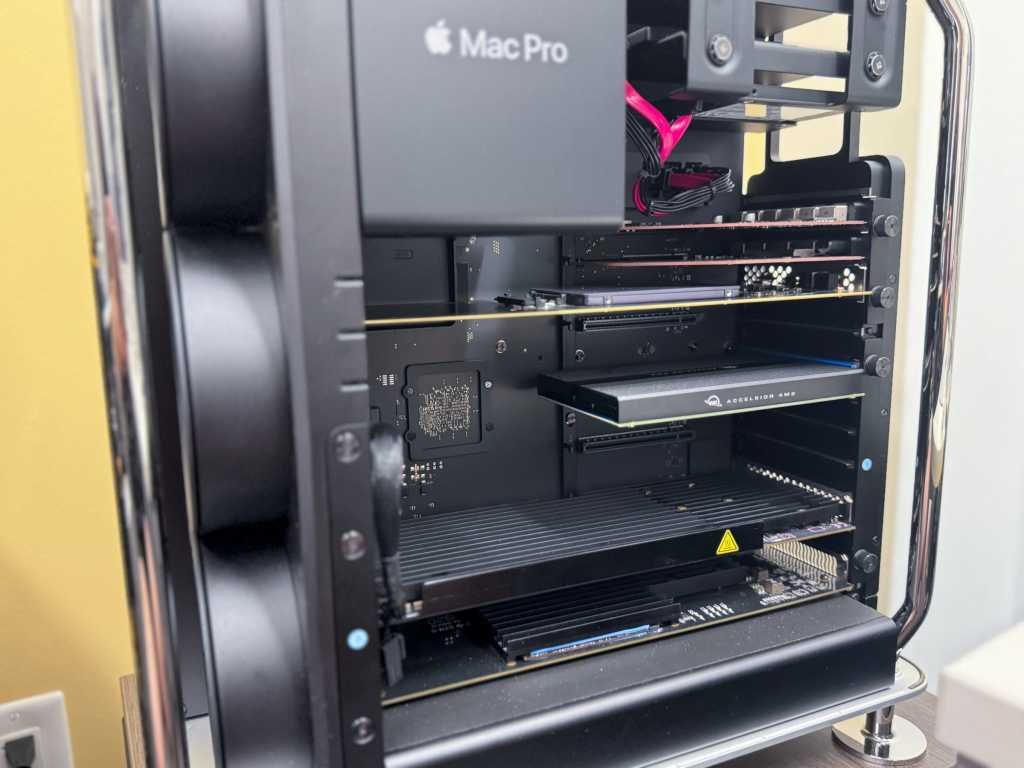The Mac Pro has drawn harsh criticism from the crowd who would normally buy one – in most cases, justifiably so. Mac Studio is alarmingly good for much cheaper.
I also shared the criticism that the Mac Pro was a bad buy. But the Mac Pro has value—a lot of it. As a fan of the 2019 Intel Mac Pro, I tried the M2 Max MacBook Pro and the Mac Studio, but found that the Mac Pro has advantages that cannot be overlooked.
Hidden costs of other Macs
When I tried to switch to a MacBook Pro as my primary Mac, the problems started almost immediately when I tried to mimic the large storage and port options that I had on my 2019 Mac Pro. I need more than the three Thunderbolt/USB 4 ports on the MacBook Pro, so I required a Thunderbolt docking station. The Mac Studio has more ports, so I did better with that, but I still needed a Sonnet Thunderbolt 4 Dock to support all the peripherals I use.
The cost savings of Mac Studio quickly begin to decrease when the cost of the required peripherals is factored in. There’s the hub, all the necessary cables to connect to the hub, and the enclosures I had to buy to house the stuff that was internally installed in my Mac Pro. If there wasn’t an enclosure available, I had to buy external replacements.
Mac Studio may be as fast as the Mac Pro, but it comes with a few extra friends on your desktop.
Thiago Trevisan/Foundry
These external replacements are where it really hits your wallet, and the cost advantage of Mac Studio shrinks significantly. More affordable USB-C external drives don’t play well with Macs – USB performance is limited at lower speeds due to Macs not supporting USB 3.2 Gen 2×2 speeds. You’ll be limited to USB 3.1 Gen 2 speeds of around 10 Gbps, about half the theoretical speed of a PC with the same drive.
This means that if you want faster performance, you should choose more expensive Thunderbolt 4 external drives that can offer up to 40 Gbps. (I cover the performance issues later in this article.)
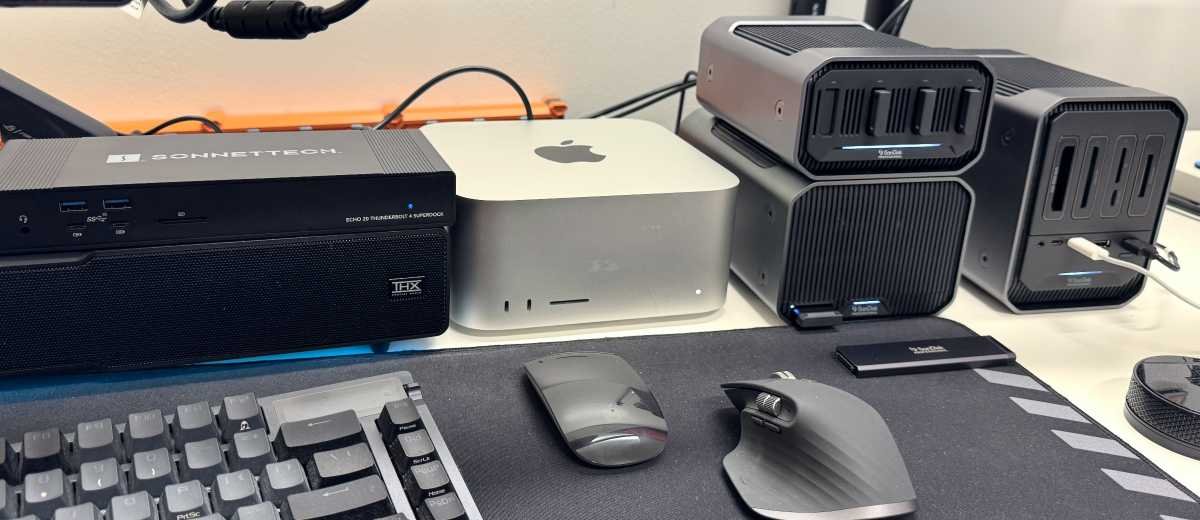
You’ll probably need a Thunderbolt Dock to support multiple devices without a Mac Pro.
Thiago Trevisan/Foundry
Granted, if you’re not a former Mac Pro user and you’re upgrading from an older MacBook Pro or desktop Mac and already have an external device setup, your setup costs may be limited.
Mess- and noise-free (mostly)
The Mac Studio and MacBook Pro may not take up much space, but they need a symphony of devices to replicate the Mac Pro’s capabilities on a desktop. The required horizontal space is multiplied by the heavy use of raid arrays, docks and external PCIe enclosures.
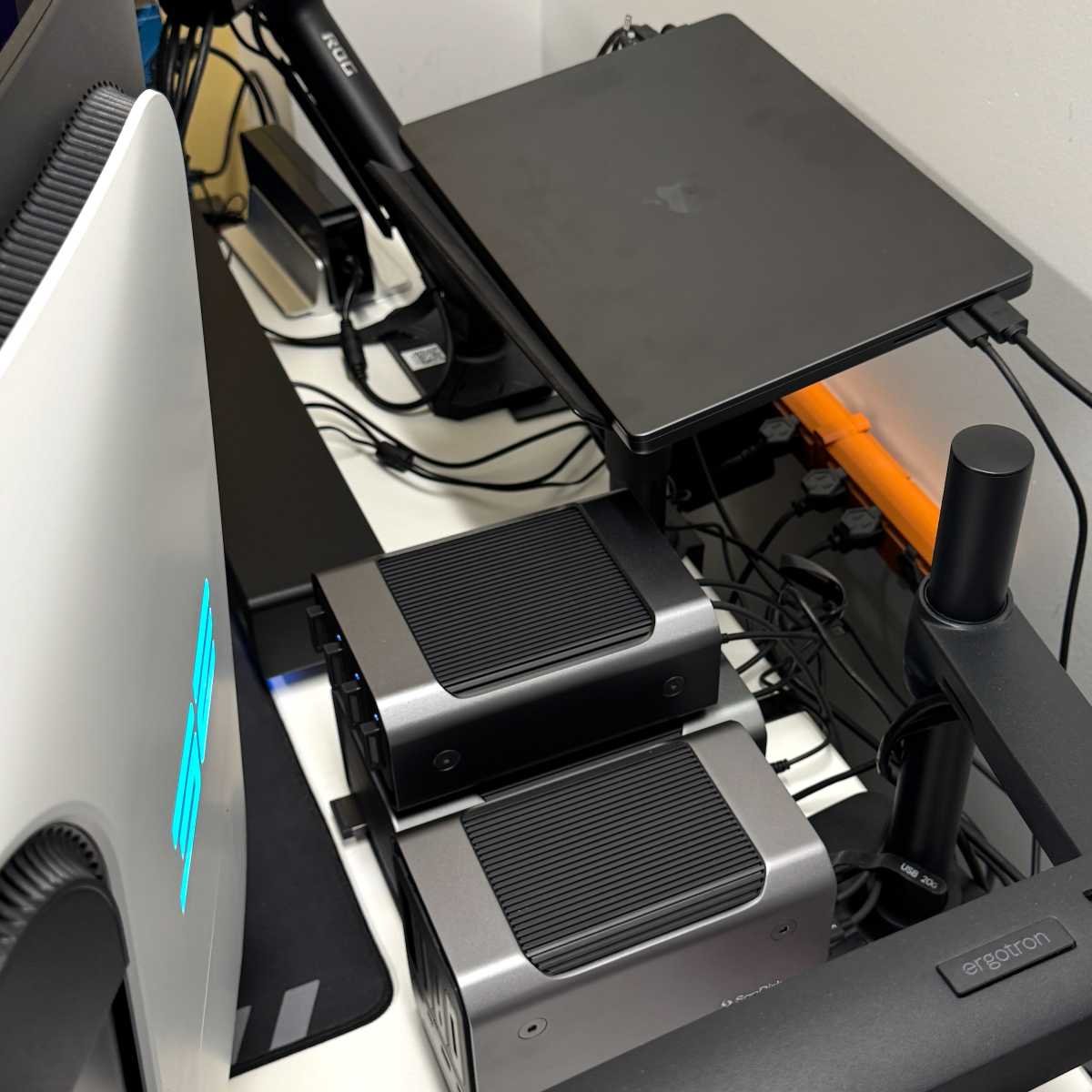
MacBook Pro M3 Max is great, but it needs a supporting number of devices
Thiago Trevisan/Foundry
In addition to all the space the peripherals take up, there’s also cable management – even if you’re a pro at it, it’s a mess to deal with. You can daisy-chain Thunderbolt devices to each other, but you’ll always have a big cacophony of cables—most peripherals need at least a power cable and their own Thunderbolt connection. Think of the Mac Pro as a large skyscraper that fits most of these devices internally and vertically—no cable clutter.
The Mac Studio and MacBook Pro are silent machines, but the included peripherals can take away that magic due to their noisy fans for cooling. Most external Thunderbolt enclosures are packaged with fans – I’ve hunted down Noctua fans to replace the standard fans in some external enclosures, adding both cost and wasted time trying to create a quieter workstation setup.
With the Mac Pro, the large fans keep PCIe cards cool, and you’ll rarely hear a whine from this elegant cheese grater masterpiece.

Cables add up quickly across necessary devices.
Thiago Trevisan/Foundry
Appreciate PCIe
You don’t have to be a sound engineer or a YouTuber to take advantage of the Mac Pro’s PCIe slots. You can skip many external Thunderbolt devices and use an internal PCIe-compatible option instead. The Mac Pro has six PCIe gen 4 slots – that’s enough to free up the Mac Pro’s external ports, and suddenly the need for an expensive Thunderbolt 4 docking station disappears.
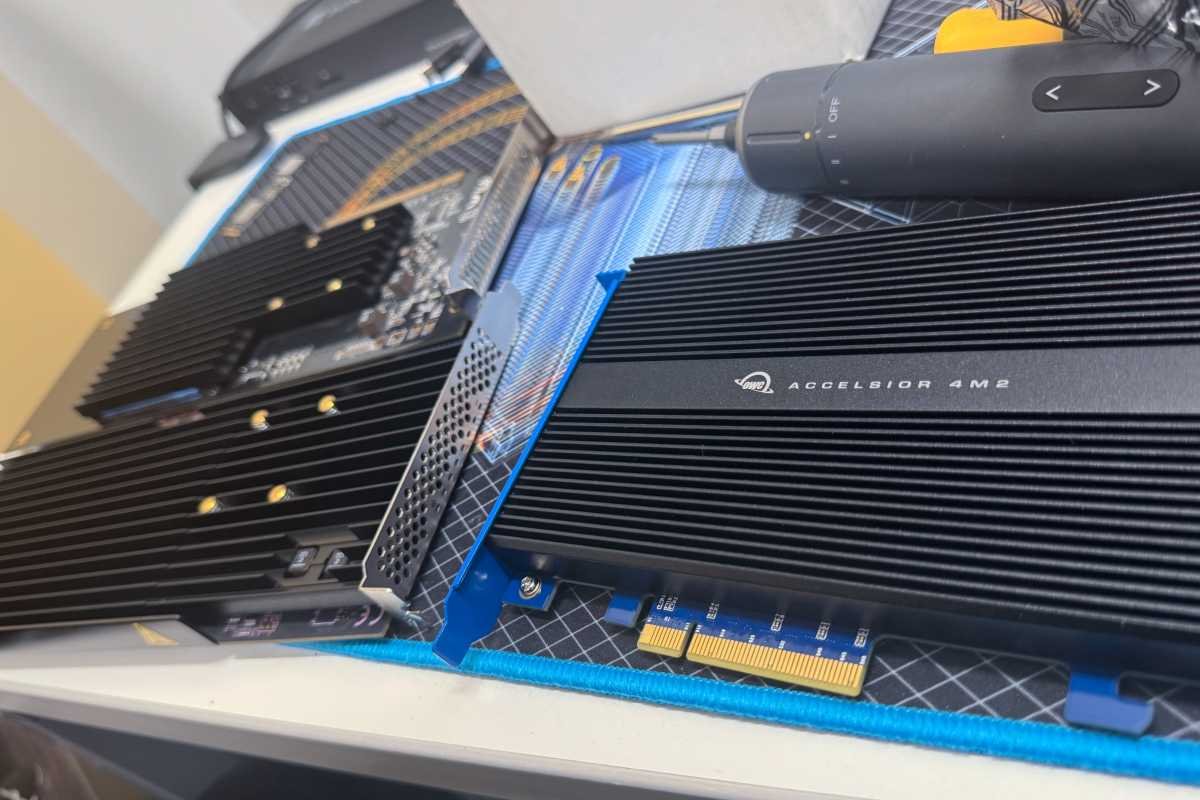
Powerful heatsinks on PCIe cards equal silence, with only Mac Pro fans needed.
Thiago Trevisan/Foundry
A minor win for the Mac Pro is that its internal Apple SSDs are upgradeable, while the Mac Studios is not. If you bought 1TB and later want 8TB, you can get it. You might want to add PCIe cards for a better price/performance ratio, but the option is there.
If you need to connect external devices, the Mac Pro has eight Thunderbolt 4 ports and two USB-A ports. It also has two HDMI ports, two gigabit ethernet ports and a 3.5mm audio jack. You don’t need to buy a dock.
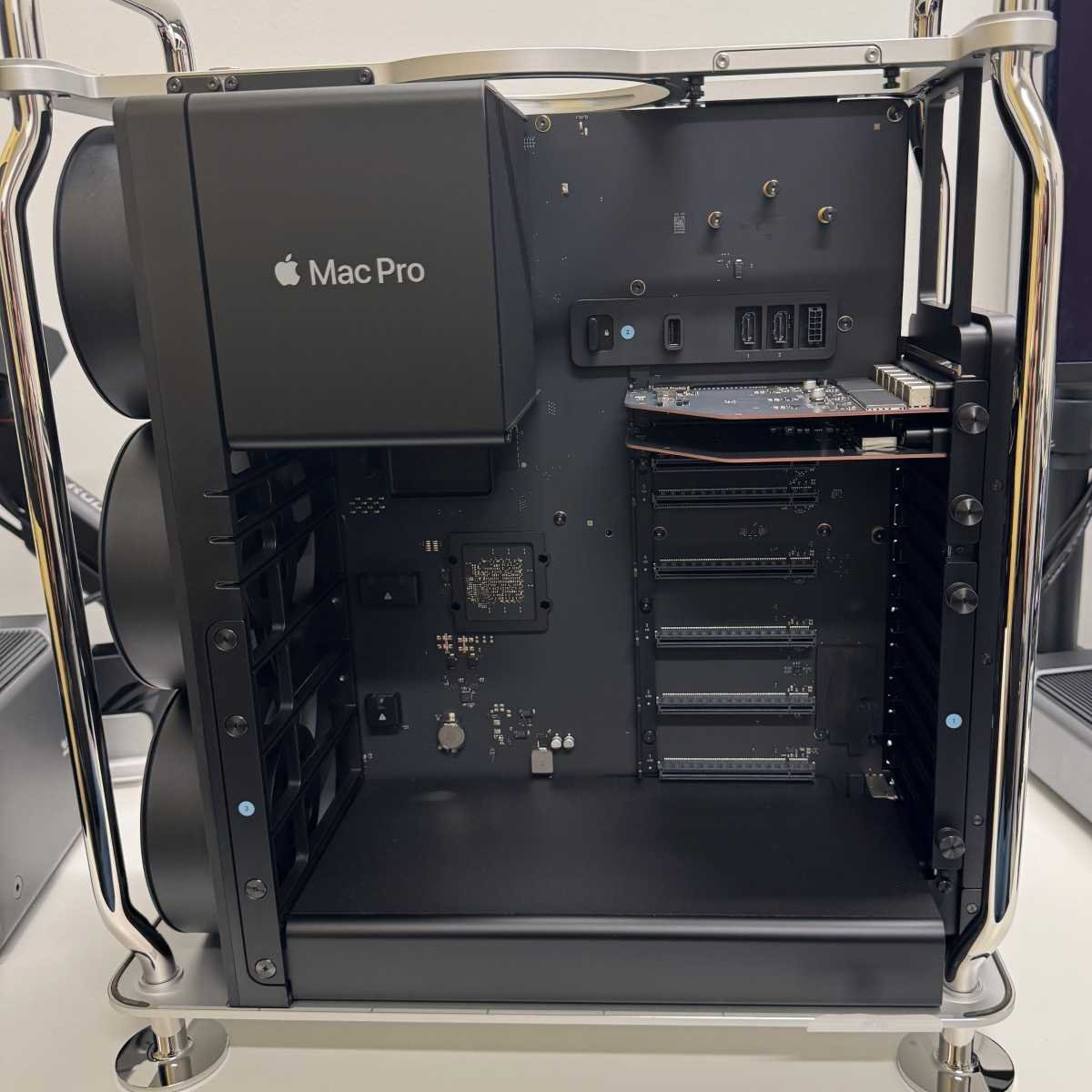
The Mac Pro has six PCIe slots.
Thiago Trevisan/Foundry
If you only need a few terabytes of storage, which can be achieved with a simple external SSD and no PCIe card, then the Mac Pro has no real advantage for you. If you need more storage space, using the Mac Pro’s PCIe slots can make a lot of sense.
Mac Pro PCIe performance
While cost, noise and clutter are important to many, the real bread and butter is in the hardware performance. Even though the Mac Pro has its bandwidth limitations with its PCIe lanes, it still beats out peripherals.
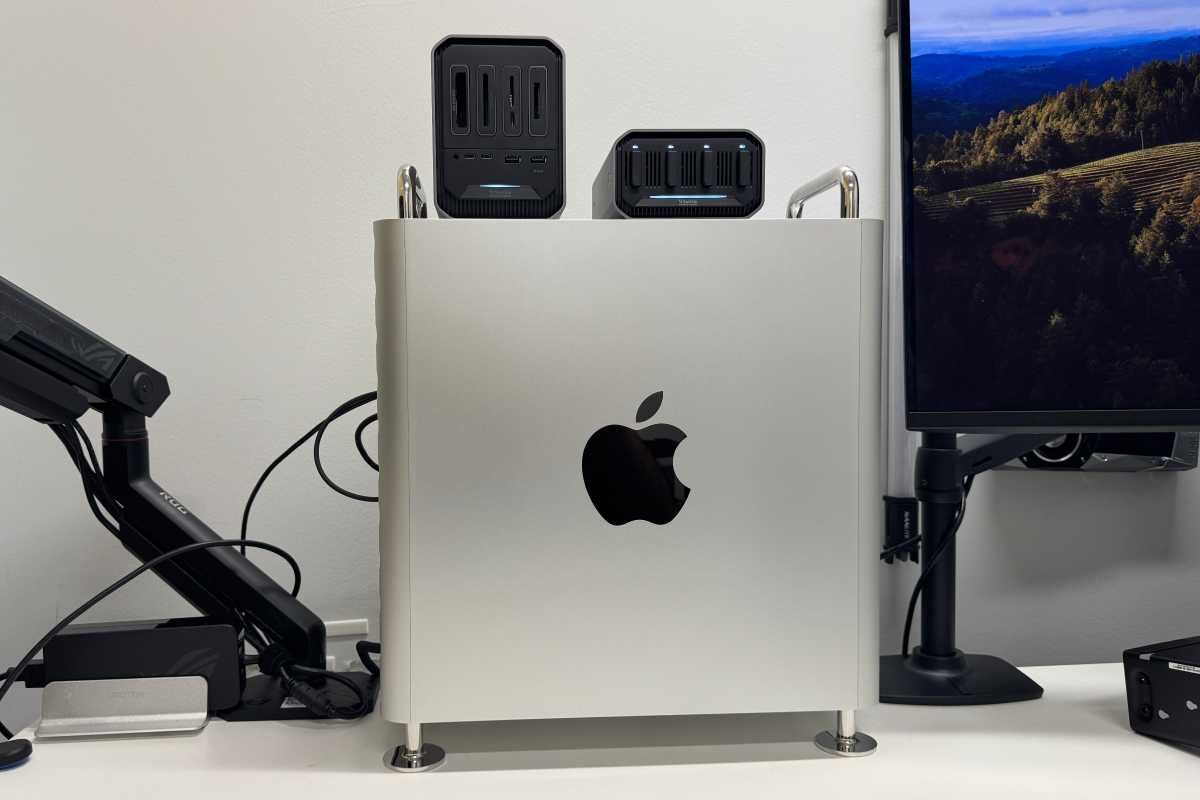
You can use external devices on the Mac Pro – it also provides a great shelf.
Thiago Trevisan/Foundry
With a fast Thunderbolt 4 external drive, such as the SanDisk Pro G40, you’ll reach nominal speeds of around 3000 MBps read and 2500 MBps write. Even with an external RAID 0 NVMe setup, such as the SanDisk Pro-Blade Station, Thunderbolt’s limitations limit speed.
You don’t have to rely on Apple’s PCIe offering either. You can get an $800 Sonnet M.2 8×4 Silent Gen4 PCIe card and then add 32TB of very fast NVMe storage and it will be about the same price as the $2,800 Apple 8TB SSD Upgrade Kit that fits into a PCIe slot . Spend more on NVMe storage and you can get up to 64TB on the Sonnet card.
The Sonnet card in one of the Mac Pro’s 16x PCIe slots can theoretically reach a whopping 30,000 MBps read and 18,000 MBps write. All of this comes in a silent package that relies on fans of the Mac Pro to quietly keep it cool.
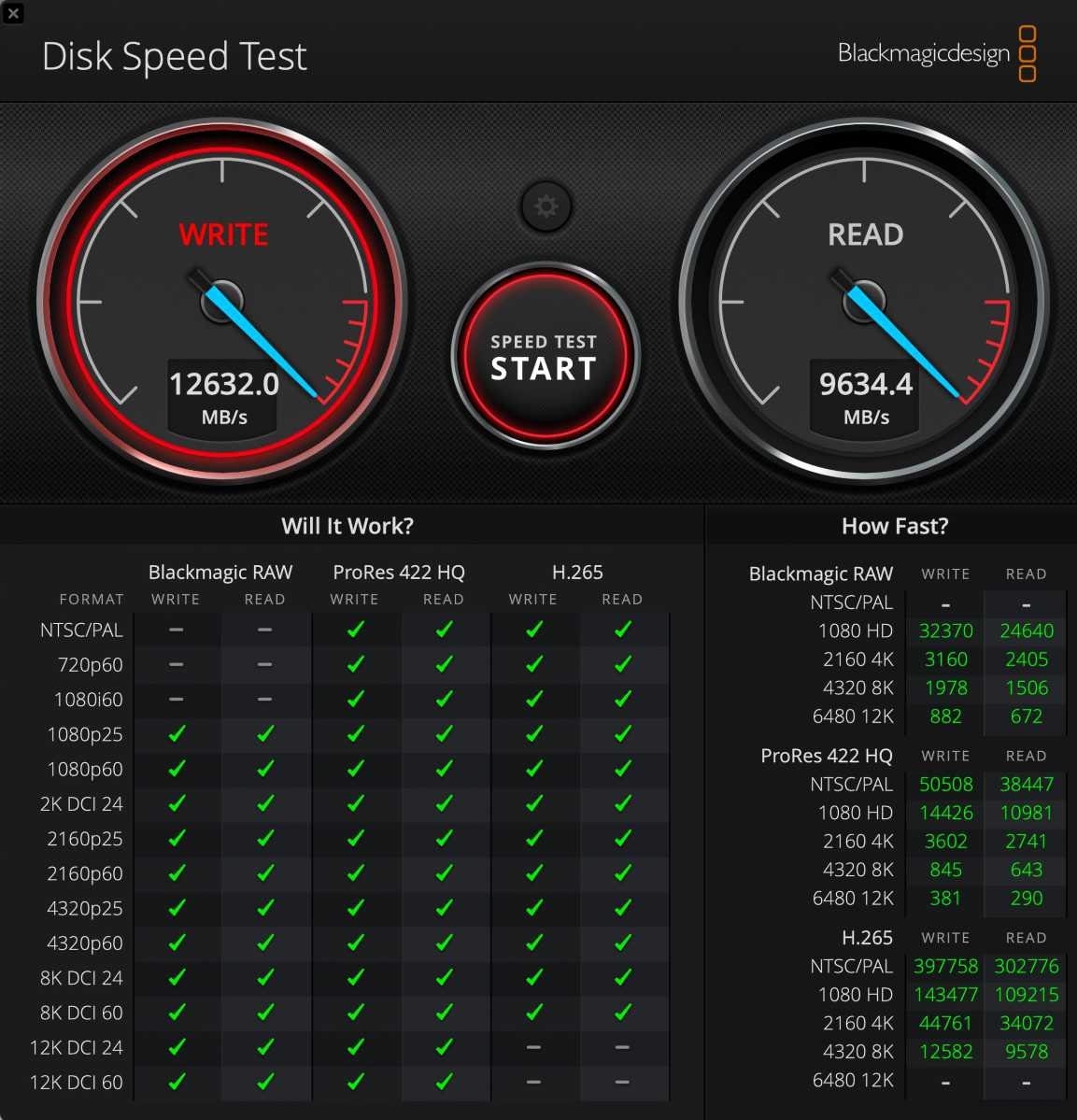
Blackmagicdesign’s Disk Speed Test benchmark of four Samsung 970 EVO Plus NVMe SSDs in a Raid 0 array on a Sonnet PCIe card.
IDG
Even a more mundane PCIe Gen 3 raid 0 of four Samsung 970 EVO NVMe SSDs results in an impressive 12,632 MBps write and 9,634 MBps read.
An OWC Accelsior 4M2 NVMe RAID 0 array with four Samsung 980 Pros installed in an 8x lane on the Mac Pro still managed 6,622 MBps write and 5,558 MBps read.
Want SSD and hard drive raid arrays for backup? You can get them, but you pay more per terabyte for external Thunderbolt enclosures marketed to MacBook Pro and Mac Studio users. They will also typically be much slower than internal PCIe cards.
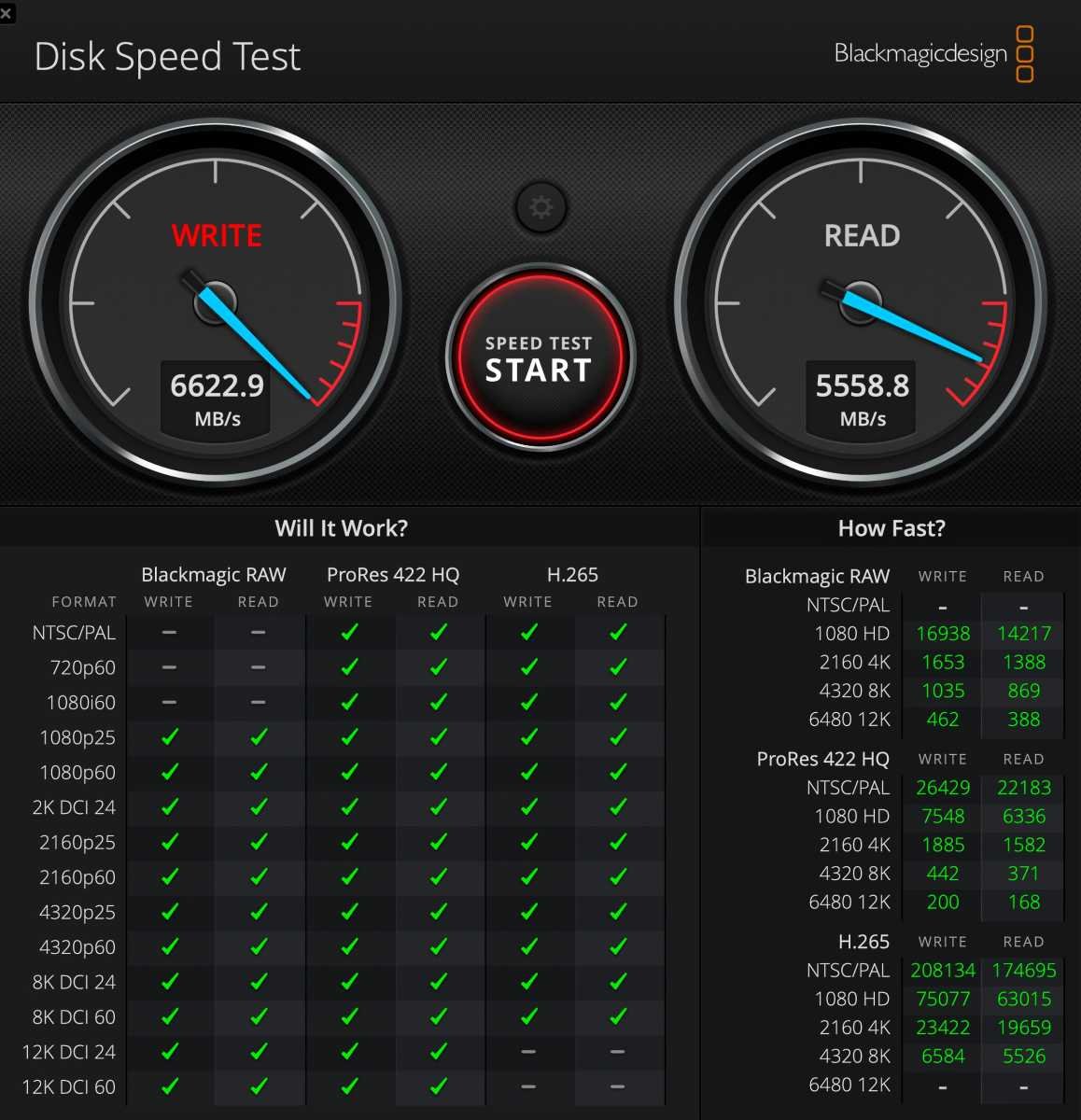
PCIe Gen 3 performance can still be impressive with the OWC Accelsior 4M2 card
Foundry
Of course, there are limits to the PCIe bandwidth of the 2023 Mac Pro. Even with this in mind, the overall usability and performance can make this cheese grater a potent sleeper workstation.
Nuances of PCIe on the Mac Pro
While the numbers are impressive, there are some very important caveats to know about how the Mac Pro handles its PCIe lanes.
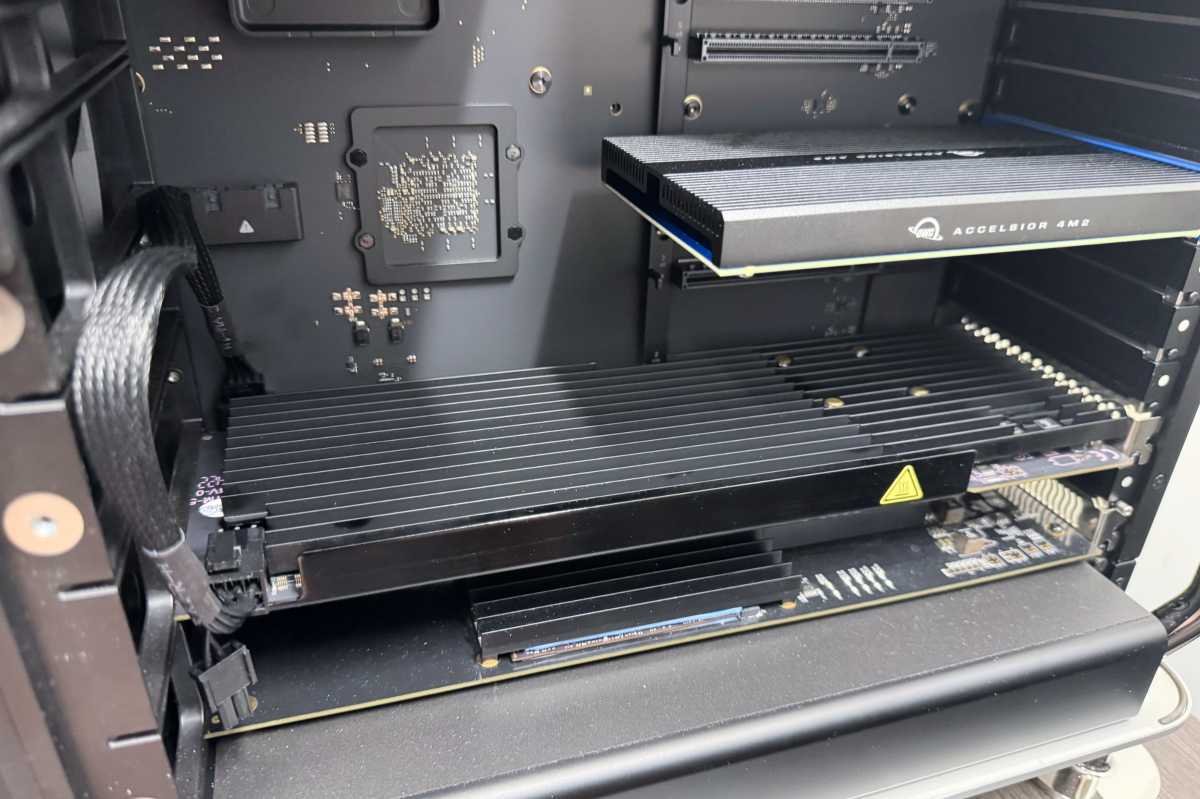
An OWC Accelsior 4M2 NVME PCIe card in an 8x lane.
Thiago Trevisan/Foundry
Here is a list of PCIe hardware that I moved over from a 2019 Mac Pro to a 2023 model. Everything below works and is visible in macOS when installed. I simply transferred it over from my new Mac Pro and it all worked – that’s a big bonus.
This includes:
- Sonnet 4×4 NVME PCIe card in the bottom 16x lane
- Sonnet 8×4 NVME PCIe card in the top 16x lane
- OWC Accelsior 4M2 NVME PCIe card in an 8x lane
- Sonnet Fusion SSD PCIe card in 8x lane number 6
- Apple-supplied I/O cards in the top slot
The PCIe lanes are shared and limited, so you can’t use them all at once and expect uncompromising performance. I use several large arrays for sequential backups (such as with Time Machine), so drops in theoretical speed are acceptable. They are still faster than any external Thunderbolt drive.
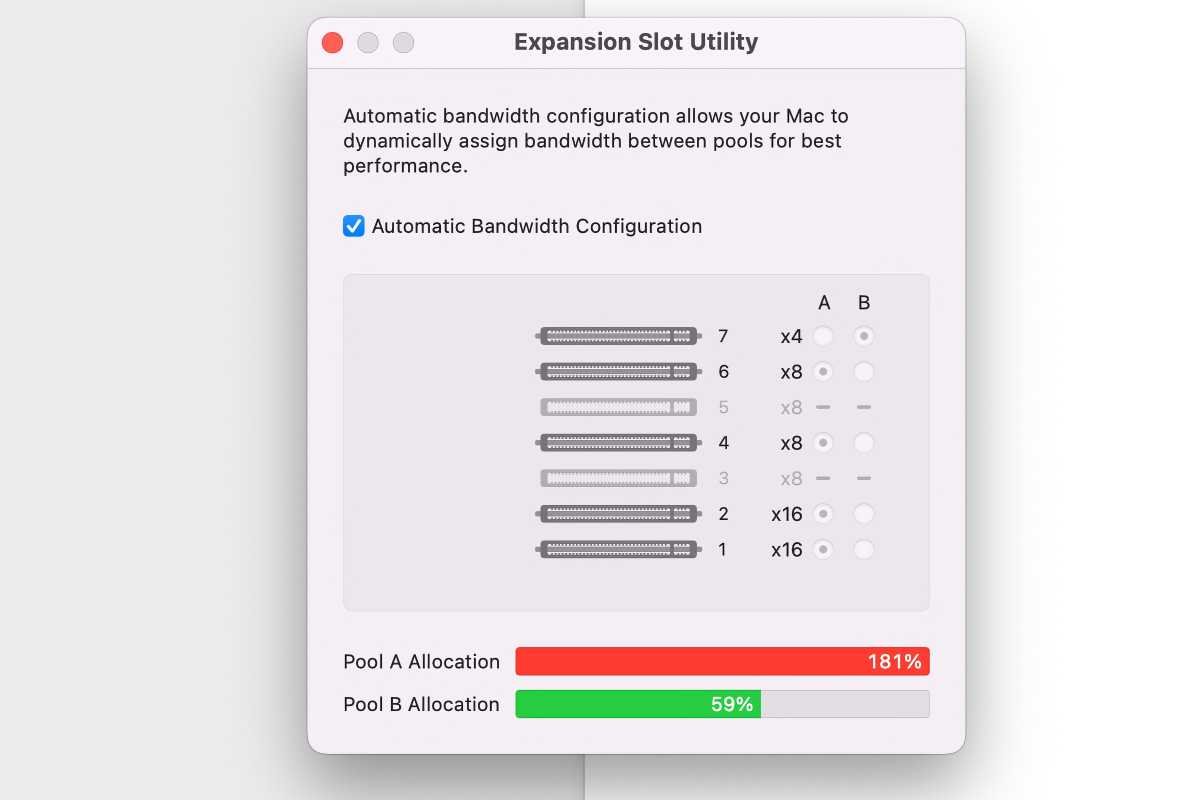
It looks scary, but it still works and automatically adjusts the bandwidth.
Foundry
The built-in Expansion Slot Utility in macOS shows my Pool A allocation at a whopping 181 percent and Pool B at 59 percent. It dynamically adjusts the bandwidth between each pool for the best performance. You can also manually assign different PCIe cards to different pools, but I found that keeping the “Automatic Bandwidth Configuration” worked best.
It might look scary, but it all works fine, just at reduced speeds if you’re trying to use more than one lane at a time. The 2019 Intel Mac Pro had a more generous allocation of bandwidth, but it also had to accommodate lane-hungry GPUs in its 16x slots, such as the Radeon W6800X Duo.
The 2019 Mac Pro also only supported PCIe Gen 3; 2023 Mac Pro supports Gen 4 speeds. This helps balance out some of the bandwidth differences, but the limits remain on Apple’s silicon.
The Thunderbolt connection is independent now with this Apple silicon Mac Pro, whereas in 2019 Mac Pro Thunderbolt also shared available bandwidth. This is why I keep at least a single Thunderbolt SanDisk Pro-Blade Station with four NVMe drives, to balance the bandwidth of the internal PCIe slots.
Even 2.5-inch SSD drives can be added to a Mac Pro. With the Sonnet J3i or Promise Pegasus J2i, it’s a simple drop-in upgrade. Hard drives with huge amounts of storage space are also easy to add.
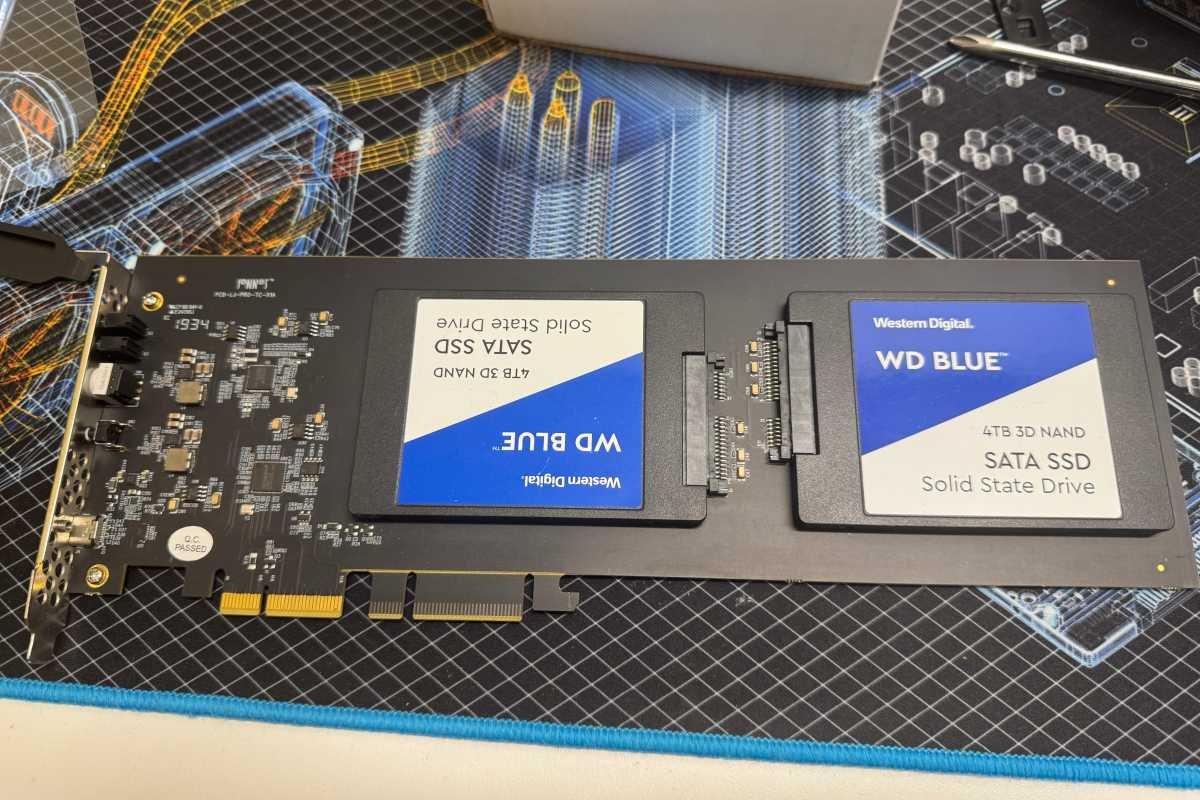
Some PCIe cards, such as this Sonnet Fusion card with two WD Blue SSDs, must be used in specific PCIe slots.
Thiago Trevisan/Foundry
A Sonnet Fusion Dual 2.5-inch SSD RAID card works, but only in slot 6 8x PCIe in the 2023 Mac Pro. (This is noted by Sonnet, who guides users to only install it in this specific slot for this Fusion card.) It played fine with the other installed NVMe PCIe cards in both the 16x and 8x slots.
Don’t overlook the Mac Pro
On paper, the Mac Pro seems like a bad deal. But for users who need tons of storage, it’s a sleeper. Adding PCIe cards is still cheaper per terabytes than adding external Thunderbolt solutions. You’ll appreciate the noise reduction, convenience and speedy performance that fits nicely into a Mac Pro. Mac Pro is an excellent combination of power and beautiful design.
